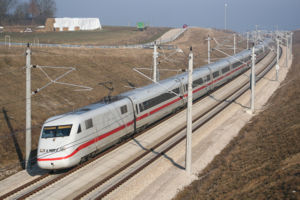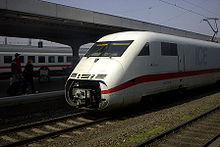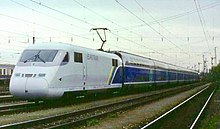ICE 2
| ICE 2 | |
|---|---|
 ICE 2 on the Nuremberg-Ingolstadt high-speed railway line | |
| Manufacturer | Adtranz, Siemens |
| Constructed | 1995 to 1997 |
| Refurbished | 2010 to 2013 |
| Number built | 46 |
| Formation | 1 power car, 6 intermediate cars, 1 control car |
| Fleet numbers | Tz 201 to 244 |
| Capacity | 391 seats |
| Operators | DB Fernverkehr |
| Depots | Berlin-Rummelsburg |
| Specifications | |
| Maximum speed | 280 km/h (170 mph) |
| Weight | 412 t (405 long tons; 454 short tons) |
| Power output | 4,800 kW (6,400 hp) |
| Electric system(s) | 15 kV 16.7 Hz AC catenary |
| Current collector(s) | Pantograph |
| Safety system(s) | Sifa, PZB90, LZB |
| Track gauge | 1,435 mm (4 ft 8+1⁄2 in) standard gauge |
The ICE 2 is the second series of German high-speed trains and one of six in the Intercity-Express family since 1995.
The ICE 2 (half-) trains are even closer to a conventional push–pull train than the ICE 1, because each train consists of only one locomotive (Class 402, called powerhead), six passenger cars (Classes 805 to 807) and a cab car (Class 808).
Differences to ICE 1



Except for the automatic Scharfenberg coupling, ICE 2 powerheads are very similar to those of the ICE 1 and can actually be used in ICE 1 trains if the necessity arises.
Half-trains
Usually two ICE 2 half-trains are coupled to form a block train of similar dimensions to the original ICE 1 for serving the main routes, and separated again to operate on routes with less traffic or to provide the passengers two different destinations.
Until the class 808 cab cars have been tested and cleared for passenger service, two ICE 2 half-trains had been solidly coupled to form a permanent block train.
Cars
The passenger cars are very different from the ICE 1 cars, despite their similar exterior: The weight has been significantly reduced and the passenger compartments have been removed in favor of a seating arrangement similar to an airliner (due to reduced seat pitch). Also, the train has been equipped with air suspension to circumvent the wheel noise problems of the ICE 1, which led to the installation of rubber-buffered wheel rims on the ICE 1 units and therefore the Eschede train disaster.
ICE 2 trains have no service car as the class 803 on ICE 1 trains, on the other hand the class 808 cab car is unique to the ICE 2.
Service

ICE 2 trains usually run on the main east–west line, starting in Berlin with two unit block train. In Hamm the train is separated into two half-trains.
One half-train goes through the Ruhr area to Cologne/Bonn Airport station, while the other half-train continues through Wuppertal and Cologne to Bonn. In the opposite direction, both half-trains are coupled again at Hamm.
Some trains also serve the Munich—Hanover line with halves continuing to Hamburg and Bremen respectively.
Eurotrain

Eurotrain was a joint venture formed by Siemens and GEC-Alsthom (today Alstom) in 1996 to market high-speed rail technology in Asia. In 1997, it was one of two competitors to supply the core system of Taiwan High Speed Rail (THSR), and was awarded the status of preferred bidder by concessionaire THSRC.[1]
In early 1998, the two companies created a demonstration train by combining cars of three existing French and German high-speed trains: ICE 2 powerheads 402 042 and 402 046, were joined at both ends to the articulated double-deck intermediate cars of TGV Duplex trainset #224. On 4 May 1998, the Eurotrain demonstration train made a presentation run on the Hanover–Würzburg high-speed railway in Germany, achieving a maximum speed of 316 km/h.[2][3]
In December 2000, THSRC decided to award the contract to the rival Taiwan Shinkansen Consortium,[1] leading to a legal battle[4] ending in damage payments for Eurotrain in 2004.[5][6]
Upgrading of electrical traction equipment
On September 25, 2014, Mitsubishi Electric Corp. of Japan announced that it had received a contract from DB to supply new IGBT (insulated-gate bipolar transistor) power modules to replace the old GTO (Gate turn-off thyristor) power modules in the drives of 46 ICE 2 trainsets. Mitsubishi said that the modern smaller and lighter IGBT power modules will reduce power consumption and extend the life of the ICE 2 trains. The contract for $22 million was expected to be completed by 2019.[7]
Future
DB was to replace the ICE 2 trains with the future ICE 4 trains.[8] but in 2022 DB fleet planning showed all 44 currently in operation will still be in operating into 2029[9]

See also
References
- ^ a b "Editorial: THSRC agreement unprincipled". Taipei Times. 2000-01-30. Retrieved 2010-10-03.
- ^ "Weitere ICE-Züge" (in German). Website über die schnellsten Züge der Welt. Archived from the original on 2009-01-18. Retrieved 2009-01-19.
- ^ "TGV Research Activities". TGVweb. Retrieved 2009-01-19.
- ^ "Eurotrain appeal rejected, might go international". Taipei Times. 2000-06-17. Retrieved 2009-01-28.
- ^ "Eurotrain Consortium v. Taiwan High Speed Rail Corporation". Analysis Group. Archived from the original on 2011-07-07. Retrieved 2010-09-29.
- ^ "Taiwan High Speed Rail to compensate railway consortium". Taipei Times. 2004-11-27. Retrieved 2009-01-28.
- ^ 'Mitsubishi wins first order from DB,' Railway Gazette International, 25 September 2014, http://www.railwaygazette.com/news/single-view/view/mitsubishi-wins-first-order-from-db.html
- ^ "DB and Siemens sign ICx contract". Railway Gazette International. 9 May 2011.
- ^ "Der 100. ICE 4 heißt "Rheinland-Pfalz"". www.deutschebahn.com (in German). Retrieved 2022-08-29.
External links
- ICE 2 Siemens page
